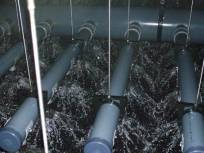A biological reactor is essential in an intensive fish farming system. The fish excrete ammonia (NH3) through the gills and urea via the urine, both of which dissolve in the water. Urea also forms ammonia, which can be harmful to fish at low concentrations. In RAS, biological filters are used to convert ammonia in a two-step process into relatively harmless nitrate (NO3). In the first step of nitrification, ammonia-oxidizing bacteria convert the ammonia into nitrite (NO2-). In the second step, this NO2- is converted by nitrite oxidizing bacteria into nitrate the end product of nitrification reaction. The nitrifying bacteria in the biofilter only perform well when the circumstances are right for them. When the organic load, in the water is too high, the nitrifying bacteria in the biofilter will be dominated by the faster growing heterotrophic bacteria. This is one of the main reasons that the biological filter is installed after the mechanical filtration steps.
ACE utilizes several biofilter types, depending on the type of fish produced, the climatic conditions and the dimensions of the farm building. Trickling filters are normally used when evaporative cooling is targeted or when the fish species has low tolerance for carbon dioxide. In other cases, moving bed biofilters (MBBR’s) may be the biofilter of choice.




